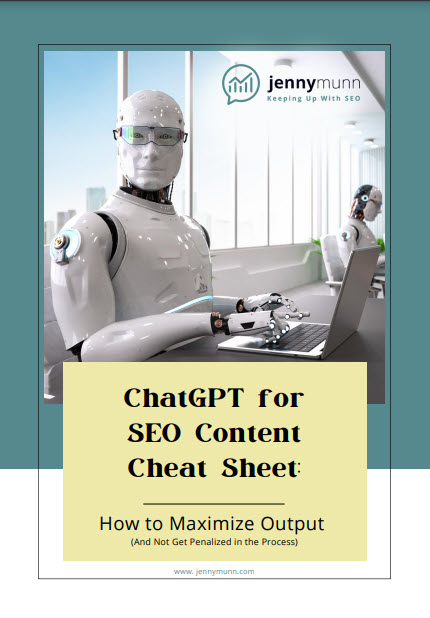Jenny’s Note: I’m delighted to bring you a guest post by colleague Tom Tortorici. Tom – a triple threat combo of marketer, writer and web designer – touches on a very important topic: all the SEO in the world isn’t going to do you any good if your website isn’t engaging to a human. Read on and enjoy!
Guest Post: Tom Tortorici talks (to himself) about how to engage, persuade and sell on websites
So Tom, you’ve been doing a presentation lately called ‘Optimized for Humans.’ What’s that all about? And what’s a post about website marketing doing here in a blog about Search?
Excellent question, Tom, thanks for asking it.
Okay, say you’re doing a search for something, and you’re presented with the first ten company links. Each of those businesses worked hard for a position where you’ll quickly find them.
So…do you reward their efforts by buying something from all ten? Of course not. Sure, you may end up engaging with one or two of those sites. But for most listings, you click the link, glance around, then hit the back button. And all the expense and effort that company put into SEO just swirled down the proverbial toilet.
In other words, those companies optimized their sites for search engines, but forgot to, well, optimize for humans.
Precisely. Hey, you’re sharper than I expected.
Thank you. I think. Anyway, who needs to learn how to optimize for humans?
I guess anyone who’s involved in the front-end of creating websites. Web designers have acquired all kinds of cool technical skills, but many don’t really have a marketing background. Chances are, the people they’re working for don’t either. Yet a company website is first and foremost a marketing tool.
Hm, I see the problem.
I thought you would. So, is your next question, “how do we optimize our websites for humans?”
Um, how did you know that?
Remember, I’m playing both sides of this interview, so’s it’s kind of hard to surprise me.
Right. So, how do we…
Okay, I’ll break it down for you. To draw web visitors in, to truly connect, to show how we can best fill their needs, it seems that we have to appeal to the eye…the mind…and the heart. And that means looking at our site not just from our point-of-view as sellers, but from the real-world perspective of our buyers.
To appeal to the eye, we have to remember that people don’t ‘read’ every word of a website, any more than they ‘read’ the Sunday paper. We scan, of course, with our eyes darting here and there, looking for interesting nuggets. So a smart website today is a scanner-friendly website.
That means we first have to give the eye a strong focus point to land on. It needs to be intriguing, so they become curious about, well, the next thing we want them to see. We have to visually emphasize what’s most important, use tempting calls-to-action, and break text content into delightfully digestible chunks, with plenty of scannable elements to hook the wandering eye.
Most importantly, we have to stand back and remove ourselves from our “insider assumptions” and be sure that what we’re selling—and its main benefit— are quickly clear to first-time visitors. Too many websites fail this simple test, which is actually a little scary.
Interesting. And what about appealing to the mind?
The key here is to realize that this isn’t just about our company or even our product. It’s really “about” that person sipping coffee and staring at their laptop, trying to solve some issue. If we use their few moments of attention to tap into what that buyer was already thinking or wondering about, they mentally lean forward. Then if our approach connects with what they’re aspiring to, they’ll actually persuade themselves that this is the right choice. It’s all about smart messaging.
Of course, we first have to understand the typical buyer’s own universe of desires, pressures, obstacles and options. Many companies, unfortunately, are too focused on what they want to say to dig deeper into what their perfect buyer needs to hear.
This is also where creativity comes in. Core messages that take a fresh, unique approach to solving the buyer’s issues make it to the foreground of their attention. Smart sites also offer useful, insightful, objective information. They genuinely help the person get around whatever barriers they’re currently facing.
On the other hand, if we’re just boasting about ourselves on our sites, or saying the same things as our competitors, we’re not really connecting with those humans out there, are we?
No, I guess not. Now, you also mentioned appealing to the heart. Does that have to do with getting people to fall in love with our website?
Um, not exactly. Think, Tom; you should be able to get this one.
Sorry. Ahh…getting people to fall in love with our product?
Well, better, but here’s what I’m really getting at: every purchase decision seems to have an emotional component. In fact, it’s been suggested that people generally make decisions based on an emotional reaction, then choose the facts later that support that decision.
So as good marketers, we first have to show that we truly understand the buyer’s frustrations. If we respond to their predicament with empathy, as well as by sharing their sense of what’s really important, that seems to create a bond. So it’s not just about explaining our product and service, is it? It’s about reducing the anxiety of an unfilled need— which triggered their online search in the first place.
The other part of this is getting people to picture how satisfied they’ll be once they’ve bought what we’re selling, which again is going to tap into their feelings. Of course, we need to do this with a sense of honestly trying to help them, by offering what we think is a superior solution. So if we let go of the idea of selling for a moment, and focus on understanding and solving needs on a deeper level, we’ll all be more successful sellers by default.
Well, thanks, that all gives all us web people a higher perspective on things. Any final thoughts?
Mm, no.
No? I’m in your head, man, I know you’ve got something else to say.
All right, one thing: If we’re building sites that only appeal to Google’s algorithm, then maybe we’re only doing half the job. But through an amazingly lucky coincidence, that algorithm is geared, more and more these days, to rewarding compelling, intriguing, useful content in the rankings. As more people stick around longer to consume all that delicious content, the more Google takes notice.
So optimizing for humans really does help optimize for search.
Couldn’t have said it better myself. Then I wonder, wow, perhaps someday Google will go beyond search and actually make my purchase decisions for me.
Maybe then you’ll be more stylishly dressed.
Yeah, maybe.
 Tom Tortorici is an Atlanta web designer, writer, and marketing guy. Visit him at TortoriciInc.com and check out his Optimized for Humans blog. If you’d like to attend the Optimized for Humans web marketing presentation, request a schedule at [email protected] .
Tom Tortorici is an Atlanta web designer, writer, and marketing guy. Visit him at TortoriciInc.com and check out his Optimized for Humans blog. If you’d like to attend the Optimized for Humans web marketing presentation, request a schedule at [email protected] .
Jenny Munn
Latest posts by Jenny Munn (see all)
- Four 2024 SEO Planning Tips for World Domination - November 16, 2023
- SEO Planning Tip: Why You Need a CYA Clause - November 3, 2023
- How Long Does SEO Take to Show Results? (Updated for 2023) - August 9, 2023




2 Comments
Proper SEO should be done with the human in mind anyway; otherwise it’s spammy and scammy, trying to “trick” search engines. And that mindset will ultimately fail.
Craig – thanks for the comment! You’re 100% right. Unfortunately though, because the spammier tactics USED to work, I think it has confused a lot of well-meaning business owners. Education is key with SEO! Thanks again, Craig.